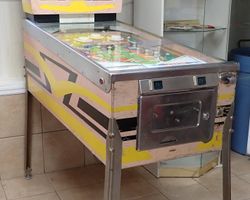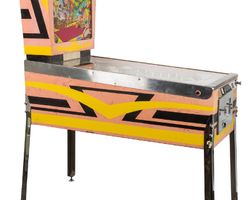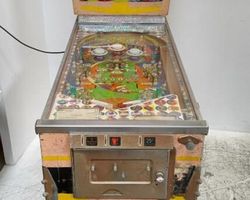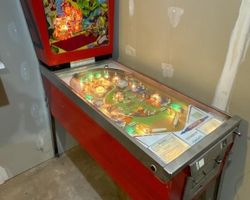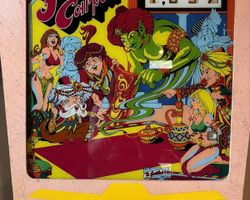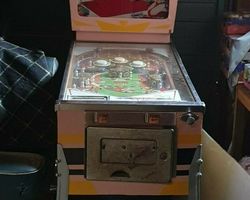Flying Carpet
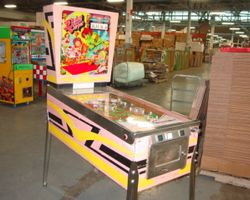
Average Prices: USD $300 to $1,000
Produced: January, 1972
Production Run: 3,170 units
Machine Type: Electro-mechanical
Players: 1
Design by: Ed Krynski
Art by: Gordon Morison
The pinball machine "Flying Carpet" transports players to a realm of magic and adventure, a hallmark creation from D. Gottlieb & Co. during the electro-mechanical (EM) era. Released to arcades and amusement locations in March of 1972, this machine, model number 310, was a testament to Gottlieb's consistent output of engaging pinball experiences. While its official production date is listed as January 1972, its public debut solidified its place in pinball history a couple of months later. A total of 3,170 units were produced, a significant run for its time, indicating a strong market presence and appeal. The design vision for "Flying Carpet" was primarily shaped by Ed Krynski, a designer known for his thoughtful playfield layouts, while the evocative artwork was brought to life by Gordon Morison. This collaborative effort ensured the machine not only played well but also captured the imagination with its theme of mystical journeys. An interesting detail in its construction is the sheer number of illumination points: "Flying Carpet" utilizes a remarkable 99 lightbulbs, with 36 illuminating the upper playfield, 28 serving as inserts, and 35 residing within the backbox, including 9 designed for blinking effects, all contributing to its visual spectacle. Remarkably, the foundational playfield design of "Flying Carpet" found a second life, serving as the blueprint for Mirco Games, Inc.'s 1975 release, "Spirit of 76," highlighting its influential and robust design.
Signature Features and Design
"Flying Carpet" distinguishes itself with a combination of visual flair and mechanical ingenuity, defining its identity within the EM pinball landscape. Gordon Morison's artistic contribution is immediately apparent in the backglass, which frequently garners praise for its thematic depiction of an Arabian night, complete with a genie, sultan, and the titular flying carpet. The playfield itself complements this theme with vibrant colors and stylized elements, creating an immersive backdrop for the action. While the backglass and playfield art resonate with many, the cabinet artwork, notably its original pink hue which often fades to a peach over time, has sometimes been a point of discussion, with some finding it less cohesive with the mystical theme.
From a mechanical standpoint, "Flying Carpet" offers several notable elements. It features two flippers, positioned for strategic shots across its symmetrical layout, and three pop bumpers, which are central to scoring and ball movement. Uniquely, the design incorporates multiple standup targets strategically positioned, some even behind the pop bumpers, a design choice that encourages dynamic play and offers rewarding shot opportunities. The machine also utilizes a mechanical reel display for scoring, typical of the EM era, providing clear, tangible feedback for every point scored. One of its subtle yet captivating visual features is the "cascading lights" located at the top of the ball arch. These lights animate as the ball travels, adding a distinctive visual flourish that enhances the overall aesthetic and excitement, particularly as the game progresses. These features collectively contribute to a cohesive experience, where the theme is reinforced by both the visual design and the interactive elements on the playfield.
Playfield and Mechanics
The playfield of "Flying Carpet" presents a well-balanced and engaging layout that encourages both precision and reactive play. Its symmetrical design is immediately apparent, offering clear paths to various scoring opportunities. Central to the playfield are the three pop bumpers, positioned to create lively, unpredictable ball action. Surrounding these bumpers and integrated into their action are a series of standup targets, forming part of the 12 total targets found on the playfield. The genius of Ed Krynski’s design becomes evident in how some of these targets are placed directly behind or adjacent to the pop bumpers, creating a delightful dynamic where bumper hits can inadvertently, or deliberately, activate these targets, often leading to increased scores or objective progression.
Major shots typically involve aiming for these pop bumper clusters and their surrounding targets, as well as navigating the ball through a series of rollover lanes positioned strategically across the upper and mid-playfield. This layout philosophy designates "Flying Carpet" as what many refer to as a "rollover game," where completing sequences of these lanes and targets is paramount to unlocking higher rewards. The lower playfield features two flippers, and notably, dual outlanes, a design choice that demands constant player attention and nudging skill. The absence of traditional slingshots, replaced by the strategic placement of the pop bumpers and targets, further defines its unique flow, pushing players to master ball control and precise flipper work.
Aesthetically, the playfield is adorned with Gordon Morison's vibrant artwork, featuring swirling patterns and thematic elements that echo the machine’s Middle-Eastern inspiration. The lighting, with its impressive 99 bulbs, is integrated thoughtfully, illuminating key targets and paths, and contributing significantly to the player’s immersion. The aforementioned cascading lights at the ball arch are a prime example of how illumination is used not just functionally, but as an engaging visual effect, enhancing the sense of a magical journey as the ball enters play. The combination of well-conceived mechanical elements and captivating visuals creates a playfield that is both challenging and visually appealing.
Gameplay Dynamics
The gameplay dynamics of "Flying Carpet" are centered around a clear, yet challenging, progression system that rewards skilled play and strategic nudging. The primary objective, and the most rewarding, involves spelling out "FLYING CARPET" through a combination of hitting specific standup targets and navigating rollover lanes. Each letter illuminated contributes to this overarching goal, and successfully completing the phrase awards a special, a highly sought-after achievement in EM pinball. Beyond this main objective, players accumulate points by activating the three pop bumpers, which often award 100 points per hit, and by striking the numerous standup targets scattered across the playfield. The mechanical reels keep track of scores up to 9,999 points, maintaining a straightforward and direct feedback loop.
"Flying Carpet" offers a choice of 3 or 5 ball play, allowing operators and players to adjust the game's duration and challenge. The design, particularly the dual outlanes and a relatively wide flipper gap, ensures that the machine remains a constant test of a player’s nudging abilities. Balls frequently find their way towards the outlanes, requiring precise nudges and shifts to keep the ball in play. This emphasis on physical interaction with the machine makes "Flying Carpet" a true "player's game," where control and recovery skills are paramount.
Scoring strategies often involve a heavy reliance on controlling the ball around the pop bumpers to maximize points and light up the associated targets. Precision shots are required to hit the specific letters needed for "FLYING CARPET," especially those positioned in less accessible areas. While the game's core scoring can feel somewhat direct, the chase for the special, combined with the constant battle against drains, provides a compelling and often addictive experience. Players often describe the game as "not too tough, not too easy," striking a balance that keeps them returning for more, striving to master its nuances and achieve the coveted special award.
Reception and Legacy
"Flying Carpet" has earned a generally positive reception within the pinball community, particularly among enthusiasts of electro-mechanical machines. Its strengths are frequently highlighted, with many praising its unique playfield layout, especially the innovative placement of targets behind the pop bumpers, which creates a distinct and engaging play experience. The action around the pop bumpers is consistently cited as a highlight, providing exciting and often high-scoring sequences. Players often describe the game as challenging but fair, asserting that it fosters strong nudging skills due to its tendency for balls to approach the wide outlanes. The pursuit of spelling "FLYING CARPET" to earn specials is a significant motivator, making the game feel rewarding upon successful completion. When properly maintained with fresh rubbers and well-adjusted mechanisms, "Flying Carpet" can play exceptionally fast, adding to its appeal. Furthermore, the backglass artwork by Gordon Morison is widely appreciated for its beauty and thematic coherence, and the cascading lights at the ball arch are noted as a visually appealing and unique feature. For many, the machine holds a nostalgic value, harking back to earlier experiences in arcades, and it is frequently considered a desirable addition to a home collection.
However, "Flying Carpet" is not without its criticisms. The most common feedback revolves around the machine’s propensity for drains, primarily attributed to the wide flipper gap and the presence of dual outlanes, which can lead to frustratingly short ball times, especially in 3-ball games. Some players find the shots required to spell "FLYING CARPET" to be exceptionally challenging, demanding a high level of precision that can be difficult to achieve consistently. The cabinet artwork, particularly its original pink color, often draws criticism for not aligning as effectively with the mystical theme as the backglass and playfield. There's also a sentiment that, for some players, especially those accustomed to more complex modern dot-matrix display (DMD) machines, the game's scoring options might feel somewhat limited or repetitive if the pop bumper scoring is maximized early in the game. Despite these points, its legacy is one of a solid "player's EM." Its playfield design’s influence is tangible, most notably serving as the basis for Mirco Games' "Spirit of 76," demonstrating a timeless quality in its mechanical layout. "Flying Carpet" remains a noteworthy example of Gottlieb's creative prowess in the early 1970s, showcasing how clever design and engaging mechanics can create a lasting and enjoyable pinball experience.
Sponsored Links
 Ebay Listings
Ebay Listings
 Auction Results
Auction Results
| Cost | Location | Date |
|---|---|---|
| USD $1,520 |  South Dakota, United States South Dakota, United States |
08 September, 2024 |
| USD $590 |  Pennsylvania, United States Pennsylvania, United States |
25 April, 2024 |
| USD $300 |  California, United States California, United States |
11 October, 2022 |
| USD $265 |  Pennsylvania, United States Pennsylvania, United States |
07 August, 2022 |
| GBP £780 |  United Kingdom United Kingdom |
22 December, 2021 |
| USD $1,075 |  Florida, United States Florida, United States |
29 November, 2020 |
| USD $204 |  Minnesota, United States Minnesota, United States |
10 November, 2020 |
| USD $1,200 |  Tennessee, United States Tennessee, United States |
08 October, 2020 |
| GBP £175 |  United Kingdom United Kingdom |
18 March, 2020 |
| GBP £550 |  Fakenham, United Kingdom Fakenham, United Kingdom |
27 January, 2020 |


Private Policy · Search Website · Contact Us
As an eBay Partner, we may earn a commission from qualifying purchases made through links on this site, at no additional cost to you.
All trademarks and copyrighted materials remain property of their respective owners. All other content copyright 2007 - 2025 Pinpedia.

